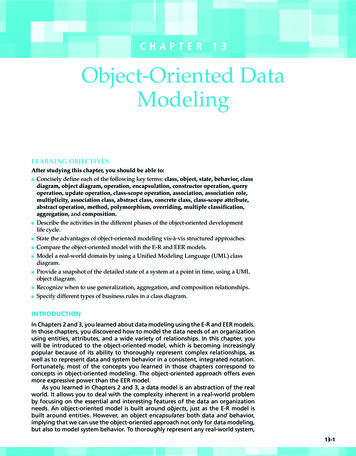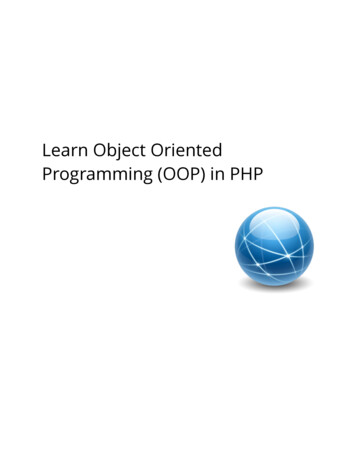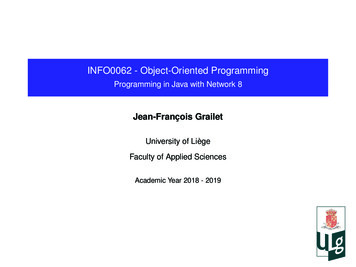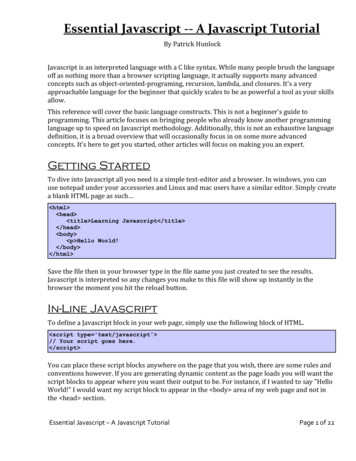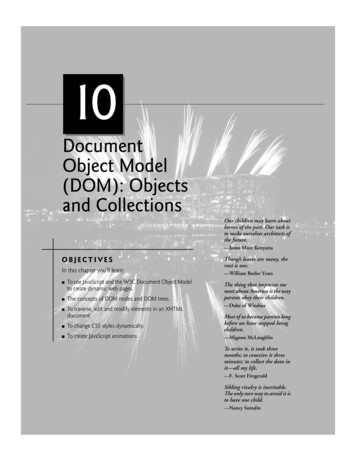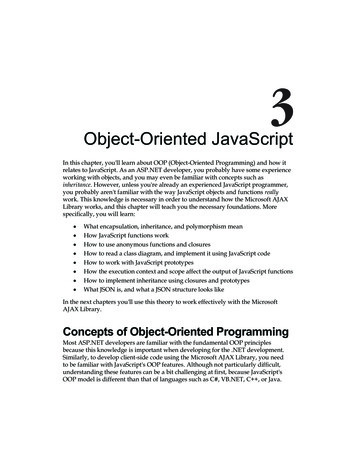
Transcription
Object-Oriented JavaScriptIn this chapter, you'll learn about OOP (Object-Oriented Programming) and how itrelates to JavaScript. As an ASP.NET developer, you probably have some experienceworking with objects, and you may even be familiar with concepts such asinheritance. However, unless you're already an experienced JavaScript programmer,you probably aren't familiar with the way JavaScript objects and functions reallywork. This knowledge is necessary in order to understand how the Microsoft AJAXLibrary works, and this chapter will teach you the necessary foundations. Morespecifically, you will learn: What encapsulation, inheritance, and polymorphism meanHow JavaScript functions workHow to use anonymous functions and closuresHow to read a class diagram, and implement it using JavaScript codeHow to work with JavaScript prototypesHow the execution context and scope affect the output of JavaScript functionsHow to implement inheritance using closures and prototypesWhat JSON is, and what a JSON structure looks likeIn the next chapters you'll use this theory to work effectively with the MicrosoftAJAX Library.Concepts of Object-Oriented ProgrammingMost ASP.NET developers are familiar with the fundamental OOP principlesbecause this knowledge is important when developing for the .NET development.Similarly, to develop client-side code using the Microsoft AJAX Library, you needto be familiar with JavaScript's OOP features. Although not particularly difficult,understanding these features can be a bit challenging at first, because JavaScript'sOOP model is different than that of languages such as C#, VB.NET, C , or Java.
Object-Oriented JavaScriptJavaScript is an object-based language. Just as in C#, you can create objects, call theirmethods, pass them as parameters, and so on. You could see this clearly when workingwith the DOM, where you manipulated the HTML document through the methodsand properties of the implicit document object. However, JavaScript isn't generallyconsidered a fully object-oriented language because it lacks support for some featuresthat you'd find in "real" OOP languages, or simply implements them differently.Your most important goal for this chapter is to understand how to work withJavaScript objects. As an ASP.NET developer, we assume that you already knowhow OOP works with .NET languages, although advanced knowledge isn'tnecessary. A tutorial written by Cristian Darie on OOP development with C# can bedownloaded in PDF format at http://www.cristiandarie.ro/downloads/.To ensure we start off from the same square, in the following couple of pages we'llreview the essential OOP concepts as they apply in C# and other languages—objects,classes, encapsulation, inheritance, and polymorphism. Then we'll continue by"porting" this knowledge into the JavaScript realm.Objects and ClassesWhat does "object-oriented programming" mean anyway? Basically, as the namesuggests, OOP puts objects at the centre of the programming model. The object isprobably the most important concept in the world of OOP—a self-contained entitythat has state and behavior, just like a real-world object. Each object is an instance of aclass (also called type), which defines the behavior that is shared by all its objects.We often use objects and classes in our programs to represent real-world objects,and types (classes) of objects. For example, we can have classes like Car, Customer,Document, or Person, and objects such as myCar, johnsCar, or davesCar.The concept is intuitive: the class represents the blueprint, or model, and objects areparticular instances of that model. For example, all objects of type Car will have thesame behavior—for example, the ability to change gear. However, each individualCar object may be in a different gear at any particular time—each object has itsparticular state. In programming, an object's state is described by its fields andproperties, and its behavior is defined by its methods and events.You've already worked with objects in the previous chapter. First, you've workedwith the built-in document object. This is a default DOM object that represents thecurrent page, and it allows you to alter the state of the page. However, you alsolearned how to create your own objects, when you created the xmlHttp object. Inthat case, xmlHttp is an object of the XMLHttpRequest class. You could create moreXMLHttpRequest objects, and all of them would have the same abilities (behavior),such as the ability to contact remote servers as you learned earlier, but each wouldhave a different state. For example, each of them may be contacting a different server.[ 82 ]
Chapter 3In OOP's world everything revolves around objects and classes, and OOP languagesusually offer three specific features for manipulating them—encapsulation,inheritance, and polymorphism.EncapsulationEncapsulation is a concept that allows the use of an object without having to knowits internal implementation in detail. The interaction with an object is done onlyvia its public interface, which contains public members and methods. We can saythat encapsulation allows an object to be treated as a "black box", separating theimplementation from its interface. Think of the objects you've worked with so far:document, a DOM object, and xmlHttp, an XMLHttpRequest object. You certainlydon't know how these objects do their work internally! All you have to know is thefeatures you can use.The "features you can use" of a class form the public interface of a class, which isthe sum of all its public members. The public members are those members that arevisible and can be used by external classes. For example, the innerHTML propertyof a DOM object (such as the default document object), or the open() and send()methods of XMLHttpRequest, are all public, because you were able to use them. Eachclass can also contain private members, which are meant for internal usage onlyand aren't visible from outside.InheritanceInheritance allows creating classes that are specialized versions of an existing class.For example assume that you have the Car class, which exposes a default interfacefor objects such as myCar, johnsCar, or davesCar. Now, assume that you wantto introduce in your project the concept of a supercar, which would have similarfunctionality to the car, but some extra features as well, such as the capability to fly!If you're an OOP programmer, the obvious move would be to create a newclass named SuperCar, and use this class to create the necessary objects such asmySuperCar, or davesSuperCar. In such scenarios, inheritance allows you to createthe SuperCar class based on the Car class, so you don't need to code all the commonfeatures once again. Instead, you can create SuperCar as a specialized version of Car,in which case SuperCar inherits all the functionality of Car. You would only need tocode the additional features you want for your SuperCar, such as a method namedFly. In this scenario, Car is the base class (also referred to as superclass), and SuperCaris the derived class (also referred to as subclass).[ 83 ]
Object-Oriented JavaScriptInheritance is great because it encourages code reuse. The potential negative sideeffect is that inheritance, by its nature, creates an effect that is known as tight couplingbetween the base class and the derived classes. Tight coupling refers to the fact thatany changes that are made to a base class are automatically propagated to all thederived classes. For example, if you make a performance improvement in the code ofthe original Car class, that improvement will propagate to SuperCar as well. Whilethis usually can be used to your advantage, if the inheritance hierarchy isn't wiselydesigned such coupling can impose future restrictions on how you can expand ormodify your base classes without breaking the functionality of the derived classes.PolymorphismPolymorphism is a more advanced OOP feature that allows using objects of differentclasses when you only know a common base class from which they both derive.Polymorphism permits using a base class reference to access objects of that class,or objects of derived classes. Using polymorphism, you can have, for example, amethod that receives as parameter an object of type Car, and when calling thatmethod you supply as parameter an object of type SuperCar. Because SuperCaris a specialized version of Car, all the public functionality of Car would also besupported by SuperCar, although the SuperCar implementations could differfrom those of Car. This kind of flexibility gives much power to an experiencedprogrammer who knows how to take advantage of it.Object-Oriented JavaScriptObjects and classes are implemented differently in JavaScript than in languagessuch as C#, VB.NET, Java, or C . However, when it comes to using them, you'llfeel on familiar ground. You create objects using the new operator, and you call theirmethods, or access their fields using the syntax you already know from C#. Here area few examples of creating objects in JavaScript:// create a generic objectvar obj new Object();// create a Date objectvar oToday new Date();// create an Array object with 3 elementsvar oMyList new Array(3);// create an empty String objectvar oMyString new String();[ 84 ]
Chapter 3Object creation is, however, the only significant similarity between JavaScript objectsand those of "typical" OOP languages. The upcoming JavaScript 2.0 will reduce thedifferences by introducing the concept of classes, private members, and so on, butuntil then we have to learn how to live without them.Objects in JavaScript have the following particularities. In the following pages we'lldiscuss each of them in detail: JavaScript code is not compiled, but parsed. This allows for flexibility whenit comes to creating or altering objects. As you'll see, it's possible to add newmembers or functions to an object or even several objects by altering theirprototype, on the fly. JavaScript doesn't support the notion of classes as typical OOP languagesdo. In JavaScript, you create functions that can behave—in many cases—justlike classes. For example, you can call a function supplying the necessaryparameters, or you can create an instance of that function supplying thoseparameters. The former case can be associated with a C# method call, andthe later can be associated with instantiating a class supplying values toits constructor. JavaScript functions are first-class objects. In English, this means that thefunction is regarded, and can be manipulated, just as like other data types.For example, you can pass functions as parameters to other functions,or even return functions. This concept may be difficult to grasp since it'svery different from the way C# developers normally think of functions ormethods, but you'll see that this kind of flexibility is actually cool. JavaScript supports closures. JavaScript supports prototypes.Ray Djajadinata's JavaScript article at aScript/ covers the OOP features in JavaScript very well, andyou can refer to it if you need another approach at learning these concepts.JavaScript FunctionsA simple fact that was highlighted in the previous chapter, but that is oftenoverlooked, is key to understanding how objects in JavaScript work: code thatdoesn't belong to a function is executed when it's read by the JavaScript interpreter,while code that belongs to a function is only executed when that function is called.[ 85 ]
Object-Oriented JavaScriptTake the following JavaScript code that you created in the first exercise of Chapter 2:// declaring new variablesvar date new Date();var hour date.getHours();// simple conditional content outputif (hour 22 hour 5)document.write("Goodnight, world!");elsedocument.write("Hello, world!");This code resides in a file named JavaScriptDom.js, which is referenced from anHTML file (JavaScriptDom.html in the exercise), but it could have been includeddirectly in a script tag of the HTML file. How it's stored is irrelevant; what doesmatter is that all that code is executed when it's read by the interpreter. If it wasincluded in a function it would only execute if the function is called explicitly, as isthis example:// call function to display greeting messageShowHelloWorld();// "Hello, World" functionfunction ShowHelloWorld(){// declaring new variablesvar date new Date();var hour date.getHours();// simple conditional content outputif (hour 22 hour 5)document.write("Goodnight, world!");elsedocument.write("Hello, world!");}This code has the same output as the previous version of the code, but it is onlybecause the ShowHelloWorld() function is called that will display "Goodnight,world!" or "Hello, world!" depending on the hour of the day. Without that functioncall, the JavaScript interpreter would take note of the existence of a function namedShowHelloWorld(), but would not execute it.Functions as VariablesIn JavaScript, functions are first-class objects. This means that a function is regardedas a data type whose values can be saved in local variables, passed as parameters,and so on. For example, when defining a function, you can assign it to a variable, andthen call the function through this variable. Take this example:[ 86 ]
Chapter 3// displays greetingvar display function DisplayGreeting(hour){if (hour 22 hour 5)document.write("Goodnight, world!");elsedocument.write("Hello, world!");}// call DisplayGreeting supplying an hour as parameterdisplay(10);When storing a piece of code as a variable, as in this example, it can make sense tocreate it as an anonymous function—which is, a function without a name. You dothis by simply omitting to specify a function name when creating it:// displays greetingvar display function(hour){.}Anonymous functions will come in handy in many circumstances when you needto pass an executable piece of code that you don't intend to reuse anywhere else, asparameter to a fun
Object-Oriented JavaScript In this chapter, you'll learn about OOP (Object-Oriented Programming) and how it relates to JavaScript. As an ASP.NET developer, you probably have some experience working with objects, and you may even be familiar with concepts such as inheritance. However, unless you're already an experienced JavaScript programmer, you probably aren't familiar with the way .File Size: 2MBPage Count: 32
